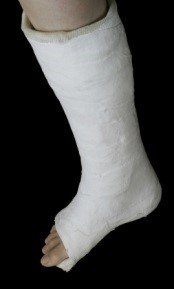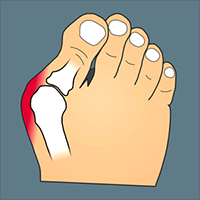Featured Articles
Items filtered by date: April 2015
Footballer Out for the Season due to Broken Ankle
 Footballer Emad Sahab of Al Orubah sustained a severe broken ankle after tumbling in a game against Al Shoalah. The ankle twisted 180 degrees.
Footballer Emad Sahab of Al Orubah sustained a severe broken ankle after tumbling in a game against Al Shoalah. The ankle twisted 180 degrees.
The game was quickly halted for a temporary amount of time as Sahab’s teammates witnessed the occurrence in great horror. Al Orubah, Sahab’s team, eventually continued their match to win 2-0. The team’s success, however, was overshadowed by the incident and Sahab’s resulting injury.
Broken ankles are very painful. If you have any concerns contact podiatrist Dr. Sharon L. Pletcher of Pennsylvania. Our doctor will treat your foot and ankle needs.
Broken Ankles
A broken ankle is experienced when a person fractures their tibia or fibula in the lower leg and ankle area. Both these bones are attached at the bottom of the leg and combine to form what we know to be our ankle.
When a physician is referring to a break of the ankle, he or she is usually referring to a break in the area where the tibia and fibula are joined to create our ankle joint. Ankles are more prone to fractures because the ankle is an area that suffers a lot of pressure and stress. There are some obvious signs when a person experiences a fractured ankle and the following symptoms may be present.
Symptoms of a Fractured Ankle
- Excessive pain when the area is touched or when any pressure is placed on the ankle
- Swelling around the area
- Bruising of the area
- Area appears to be deformed
If you suspect an ankle fracture, it is recommended to seek treatment as soon as possible. The sooner you have your podiatrist diagnose the fracture, the quicker you’ll be on the way towards recovery.
If you have any questions please feel free to contact our office located in State College, PA. We offer the newest diagnostic tools and technology to treat your foot and ankle needs.
Read more about broken ankles.
The Difference between Facts and Myths of Bunions
 When it comes to bunions, the enlargement of the joint in the big toe, there are many facts and myths. For example, it is a fact that bunions are one of the most common foot problems in the United States and occur in nearly one fourth to one third of Americans. Myths of bunions include having surgery even if the bunion is not painful, bunion surgery is unbearably painful, and in order to have a successful surgery you would have to take off of work for a prolonged period of time.
When it comes to bunions, the enlargement of the joint in the big toe, there are many facts and myths. For example, it is a fact that bunions are one of the most common foot problems in the United States and occur in nearly one fourth to one third of Americans. Myths of bunions include having surgery even if the bunion is not painful, bunion surgery is unbearably painful, and in order to have a successful surgery you would have to take off of work for a prolonged period of time.
Bunion sufferers should only have surgery on a painful bunion if the joint continues to grow and when it creates a problem when engaging in physical activity.
Bunions can become a serious condition if not treated properly. If you want to better understand the facts and myths of your foot problem contact podiatrist Dr. Sharon L. Pletcher of New York. Our doctor will treat your foot and ankle needs.
What is a Bunion?
A bunion is formed of swollen tissue or an enlargement of boney growth, usually located at the base joint of the toe that connects to the foot. The swelling occurs by the bones in the big toe shifting inward, which impacts the other toes of the foot. This causes the area around the base of the big toe to become inflamed and painful.
Why do Bunions Form?
- Genetics – susceptibility to bunions are often hereditary
- Stress on the feet – poorly fitted and uncomfortable footwear that places stress on feet, such as heels, can cause bunions to form
How are Bunions Diagnosed?
Doctors often perform two tests – blood tests and x-rays – when trying to diagnose bunions, especially in the early stages of development. Blood tests help determine if the foot pain is being caused by something else, such as arthritis, while x-rays provide a clear picture of your bone structure to your doctor.
How are Bunions Treated?
- Refrain from wearing heels or similar shoes that cause discomfort
- Select wider shoes that can provide more comfort and reduce pain
- Anti-inflammatory and pain management drugs
- Orthotics or foot inserts
- Surgery
If you have any questions please feel free to contact our office located in State College, PA. We offer the newest diagnostic tools and technology to treat your foot and ankle needs.
Read more about bunions.
New Treatment Helps Relieve Heel Pain Caused by Plantar Fasciitis
Recently, a groundbreaking study concluded that their treatment combining ultrasound with steroid injections was 95% effective in the treatment of plantar fasciitis.
Plantar fasciitis is a foot problem affecting the plantar fascia, a connective tissue in the heel. This condition is treatable, but in many cases can take up to a year to be effective.
Conventional treatments have included exercises, rest, arch supports, and night splints. If this proves to be ineffective, many patients undergo shockwave therapy. In shockwave therapy, sound waves are directed to the area where pain is experienced. This therapy can be affective, but is somewhat painful, and calls for several sessions. Even still, shockwave therapy does not always alleviate the pain caused by plantar fasciitis.
Luca M. Sconfienza, M.D., from the University of Genoa in Italy, conducted the study. The new treatment involves an ultrasound-guided technique with a steroid injection to the plantar fascia. It is a one-time outpatient procedure involving a small amount of anesthesia. This technique, known as dry-needling, causes small amounts of bleeding that aid in healing the fascia.
It was discovered that 42 of the 44 patients involved in the study had their symptoms disappear entirely within three weeks. “This therapy is quicker, easier, less painful, and less expensive than shockwave therapy” Dr. Sconfienza stated. “In cases of mild plantar fasciitis, patients should first try non-invasive solutions before any other treatments. But when pain becomes annoying and affects the activities of daily living, dry-needling with steroid injection is a viable option," she added.





 A new study being conducted by
A new study being conducted by  A new study being conducted by
A new study being conducted by